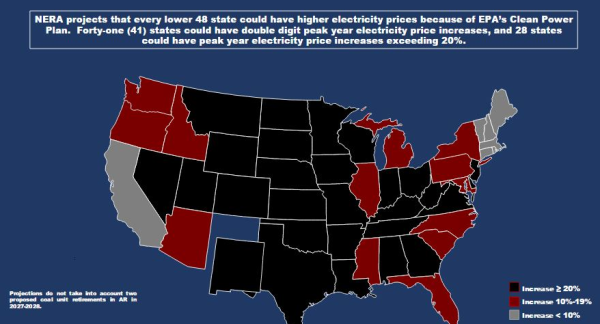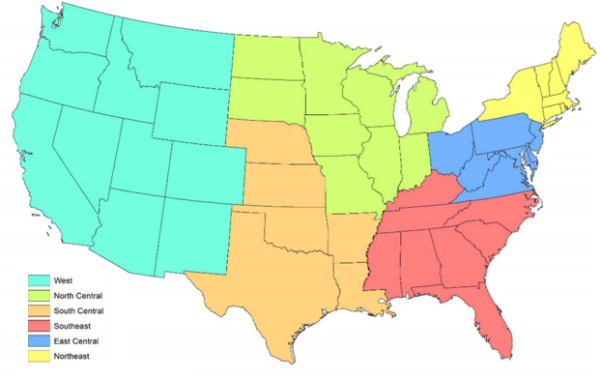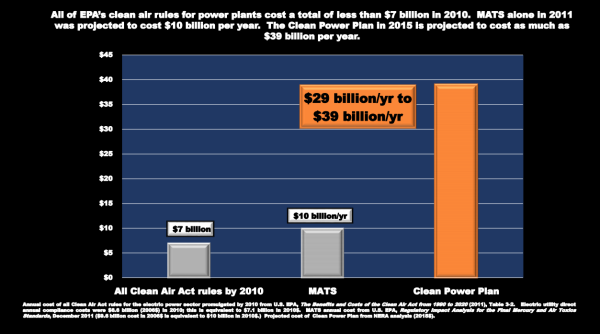According to a recent study by NERA Economic Consulting, EPA’s regulation of carbon dioxide from power plants, the so-called “Clean Power Plan” (CPP), will hike electricity prices in all 47 states that are subject to the regulation. Of those 47 states, 41 states are projected to see double-digit “peak” electricity price increases and 28 states are projected to see “peak” electricity price increases greater than 20 percent.[i] The plan’s projected cost of at least $29 billion annually is three times greater than the cost of EPA’s Mercury and Air Toxics rule, to which the U.S. Supreme Court stated, “It is not rational … to impose billions of dollars in economic costs in return for a few dollars in … benefits.” The benefits of the CPP are miniscule, reducing global carbon dioxide emissions by less than 1 percent and global temperatures by 0.02 degrees Celsius by 2100, according to EPA’s own models.[ii]
Source: http://watchdog.org/246137/clean-power-plan-6/
NERA projects much higher costs than EPA because[iii]:
- EPA projects that the upfront cost of energy efficiency will decline over time and that electricity prices will also eventually decline as investments in energy efficiency pay off. In contrast, NERA assumes that the lower cost options will be accomplished first and the more costly ones later, resulting in higher electricity prices over time.
- EPA underestimates the amount of coal-fired capacity that will be prematurely retired due to the CPP. EPA assumes about 100,000 megawatts of coal — about one-third of the nation’s fleet — will be retired due to other EPA regulations before the CPP goes into effect. NERA, however, projects that 47,000 megawatts of coal will be prematurely retired due to the CPP. Because EPA assumes more coal retirements before the CPP takes effect, fewer coal plants are left to prematurely close, making EPA’s analysis of the CPP less costly.
The NERA Study
NERA evaluated 2 scenarios, using an energy economic model, evaluating the impacts relative to a base case without the CPP, which is calibrated to the Energy Information Administration’s Annual Energy Outlook 2015. The scenarios differ based on the amount of trading assumed: either intra-state or regional. Regional trading is based on the 6 regions developed by EPA and depicted below:
Source: NERA, http://www.americaspower.org/wp-content/uploads/2015/11/
NERA-CPP-Final-Nov-7.pdf
The analysis determines the least cost compliance options from those the CPP allows, including end-use energy efficiency. For each scenario, two different assumptions are evaluated based on the allocation of allowances to local distribution companies (LDCs):
- No LDC allocation where all allowances are auctioned
- 50% LDC allocation where half of the allowances are auctioned and the other half are distributed at no cost to LDCs and used as credit to retail rates
It is assumed that the LDCs pass free allowances to electricity consumers by lowering rates. However, regardless of the case, the revenue from the allowances is returned to households either through lower rates or through other means.
The impacts are:
- Average U.S. electricity rate increases range from 11 percent per year to 14 percent per year between 2022 and 2033
- Losses to consumers range between $64 billion and $79 billion on a present value basis over the same time period
- Energy sector expenditure increases range from $220 to $292 billion (spending from 2022 through 2033, brought to present value in 2016), averaging between $29 and $39 billion per year. Energy expenditures include changes in electricity generation costs, energy efficiency costs, and natural gas costs to non-electric consumers. Expenditures do not include increased costs for transmission and distribution and natural gas infrastructure.
- Carbon dioxide emissions are reduced between 19 percent and 21 percent from the emissions in the base case and are projected to be 36 percent to 37 percent lower than they were in 2005 by 2031.
Most Costly EPA Rule for Power Plants
At $29 to $39 billion per year, the CPP is the most costly rule ever promulgated by EPA for power plants. All of EPA’s clear air regulations for power plants cost less than $7 billion in 2010. In 2011, the Mercury and Air Toxic Standard was projected to cost $10 billion per year. In 2015, the CPP is projected to cost as much as $39 billion per year. (See graph below.)
Source: http://www.americaspower.org/wp-content/uploads/2015/11/
CPP-vs-Other-Rules-Nov-7.pdf
Conclusion
According to the NERA analysis, the EPA has severely underestimated the cost of compliance with its regulation of carbon dioxide from power plants, and by doing so it is trying to make Americans believe that the government can force the electric generating sector to eliminate a massive amount of low-cost coal-fired generation for little or relatively no cost. U.S. consumers of electricity will pay for prematurely retiring coal-fired plants through substantially higher electricity prices. Because EPA has set emission reduction targets by state, the impact of the higher costs will not be borne equally, but 40 states (out of 47 affected) could see average electricity prices rise by 10 percent or more and 27 states could see average electricity prices increase 20 percent or more.
The CPP, if allowed by the courts to proceed, will be the costliest EPA regulation affecting the U.S. generating sector and all Americans consumers. With no real impact on temperature – 2/100ths of one degree celsius in 2100 – the EPA’s regulation seems more consistent with President Obama’s campaign promise to make “electricity prices necessarily skyrocket” than to moderating global climate change. Policymakers should know that this costliest of electric power regulations actually achieves meaningless progress towards the goal that EPA uses to justify it.
[i] NERA Economic Consulting, Energy and Economic Impacts Of EPA’s Clean Power Plan, November 7, 2015, http://www.americaspower.org/wp-content/uploads/2015/11/NERA-CPP-Final-Nov-7.pdf
[ii] Institute for Energy Research, https://www.instituteforenergyresearch.org/analysis/obamas-clean-power-plan-should-be-called-the-costly-power-plan/
[iii] Watch Dog, A big financial hit for the Clean Power Plan? Study claims price hike in 47 states, November 11, 2015, http://watchdog.org/246137/clean-power-plan-6/






